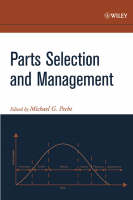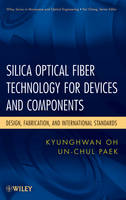Parts Selection and Management
 -15%
portes grátis
-15%
portes grátis
Parts Selection and Management
Pecht, Michael
John Wiley & Sons Inc
02/2004
340
Dura
Inglês
9780471476054
15 a 20 dias
862
An Additional Acknowledgment.
Editor.
Authors.
Acronyms.
Chapter 1. Motivation for a Parts Selection and Management Program (Sanjay Tiku and Michael Pecht).
1.1 Technology Advances.
1.2 Market Challenges.
1.3 Sypply Chain Trends.
1.4 Availability and Life Cycle Mismatch Issues.
1.5 Standards Reorganization.
1.6 Objectives of a Parts Selection and Management Program.
1.7 References.
Chapter 2. Methodology for Parts Selection and Management (Margaret Jackson, et al.).
2.1 Responsbilities and Composition of the Parts Management Team.
2.2 The Overall Parts Selection and Management Methodology.
2.3 Product Requirements and Constraints Identification.
2.4 Technology Sensing and Cascading.
2.5 Candidate Part and Part Manufacturer Selection.
2.6 Manufacturer, Part, and Distributor Assessments.
2.7 Determination of the Local Environment.
2.8 Performance Assessment.
2.9 Reliability Assessment.
2.10 Assembly Assessment.
2.11 Life Cycle Mismatch Assessment.
2.12 Risk Management.
2.13 References.
Chapter 3. Product Requirements, Constraints, and Specifications (Peter Sandborn and Chris Wilkinson).
3.1 Product Requirements Definition and Realization Constraints.
3.2 Who Defines the Requirements and Constraints?
3.3 Requirements and Constraints Definition Risks.
3.4 The Requirements Document.
3.5 Approving Requirements and Contraints - Buy-in.
3.6 Preliminary Specification.
3.7 Requirements Tracking.
3.8 Summary.
3.9 References.
Chapter 4. Using the Part Datasheet (Diganta Das and Michael Pecht).
4.1 The Contents of a Datasheet.
4.2 The Status of the Part and Datasheet.
4.3 The Part Number.
4.4 Ratings of an Electronic Part.
4.5 Reliability Information.
4.6 Thermal Characteristics.
4.7 Electrical Specifications.
4.8 Derating and Safe Operating Area.
4.9 Summary.
4.10 References.
Chapter 5. Candidate Parts Selection: Making the First Cut (Diganta Das and Peter Sandborn).
5.1 Candidate Part Identification Process.
5.2 Part Databases.
5.3 Part Procurement.
5.4 Summary.
5.5 References.
Chapter 6. Manufacturer Assessment Procedure and Criteria (Toby Syrus, et al.).
6.1 Manufacturer Assessment Process.
6.2 Manufacturer Identification.
6.3 Manufacturer Assessment Categories.
6.4 Results.
6.5 Summary.
6.6 References.
Chapter 7. Part Assessment Guidelines and Criteria (Toby Syrus, et al.).
7.1 Part Assessment Process.
7.2 Part Grouping.
7.3 Part Assessment Categories.
7.4 Case Study Results.
7.5 Summary.
7.6 References.
Chapter 8. Electronic Part Distribution and Distributor Assessment (Sanjay Tiku, et al.).
8.1 Why Part Manufacturers Use Distributors.
8.2 Why Customers Buy From Distributors.
8.3 Types of Electronic Parts Distributors.
8.4 Distributor Identification for Assessment.
8.5 Distributor Assessment.
8.6 Summary.
8.7 References.
Chapter 9. Tracking Part Changes Through the Part Supply Chain (Steven Murray, et al.).
9.1 Introduction.
9.2 Manufacturers Change Control.
9.3 Standards and Authorities for Notifying Customers of Part Changes.
9.4 Change Notification Paths.
9.5 Case Study: Change Notification Policies in Practice.
9.6 Case Study: Examples of Commonly Made Changes.
9.8 References.
Chapter 10. Parts Selection and Management to Avoid Counterfeit Electronic Parts (Sanjay Tiku, et al.).
10.1 Business and National Security Implications of Conterfeiting.
10.2 Examples of Counterfeit Electronic Parts.
10.3 Legislative Initiatives and Organized Activities Against Counterfeiting.
10.4 Preventing Counterfeiting of Parts: Recommendations for Electronic Part Manufacturers.
10.5 Preventing Supply of Counterfeit Parts: Recommendations for OEMs.
10.6 Summary.
10.7 References.
Chapter 11. Equipment Supplier Intervention Techniques (Anant Mathur, et al.).
11.1 The Parts Selection and Management Process.
11.2 Why Use Equipment Supplier Intervention?
11.3 Methods of Equipment Supplier Intervention.
11.4 Cost Implications of Equipment Supplier Intervention.
11.5 Provisional Acceptance.
11.6 Case Study.
11.7 Summary.
11.8 References.
Chapter 12. Determination of the Life Cycle Environment (Niranjan Vijayaragavan, et al.).
12.1 Defining the Life Cycle Environmental Profile.
12.2 Steps in Developing an LCEP.
12.3 Considerations and Recommendations.
12.4 Life Cycle Phases and Environmental Factors.
12.5 Environmental Factors and Their Effects.
12.6 Quantification of Environmental Loads.
12.7 Summary.
12.8 References.
Chapter 13. Performance (Diganta Das, et al.).
13.1 Methods of Mitigating the Discrepancy Between System Needs and Part Ratings.
13.2 Methods of Uprating.
13.3 Parameter Conformance.
13.4 Parameter Recharacterization.
13.5 Stress Balancing.
13.6 Reliability Issues with Uprating.
13.7 Case Study: Single Inline Memory Module.
13.8 References.
Chapter 14. Reliability Assessment (Michael Pecht and Jingsong Xie).
14.1 Candidate Part.
14.2 Life Cycle Loads.
14.3 Using Tests to Assess Reliability.
14.4 Using Virtual Reliability Assessment to Assess Reliability.
14.5 Using Accelerated Testing to Assess Reliability.
14.6 Conduct the Accelerated Tests.
14.7 Summary.
14.8 References.
Chapter 15. Assembly Requirements and Constraints Assessment (Peter Sandborn and Michael Pecht).
15.1 Assembly Compatibility.
15.2 Routing Compatibility.
15.3 Test and Rework Acceptability.
15.4 References.
Chapter 16. Obsolescence Prediction and Management (Michael Pecht, et al.).
16.1 Life-cycle Stages.
16.2 Life-cycle Forecasting Methodology.
16.3 Obsolescence Management Tactics and Strategies.
16.4 Economics of Obsolescence Management Strategies.
16.5 References.
Chapter 17. Part Acceptance and Risk Management (Peter Sandborn).
17.1 Risk Assessment Process.
17.2 The Risk Pool.
17.3 Managing Risks During Part Selection.
17.4 Management Plan.
17.5 Management During Part Use.
17.6 Unmanaged Risks.
17.7 Summary.
17.8 References.
Chapter 18. Environmental and Legislative Issues (Paul Casey and Yuki Fukuda).
Legislation for Eliminating Lead in Electronics.
18.2 Lead-free Components.
18.3 Environmentally Friendly Molding Compounds.
18.4 Industry Groups Involved with Lead and Halogen-free Electronics.
18.5 References.
Chapter 19. Legal Liabilities (Ray Biagini and Michael Pecht).
19.1 Determining the Plaintiffs and the Defendants.
19.2 Determining the Court That Will Hear the Case.
19.3 The Plaintiff's Claims.
19.4 The Defendant's Rebuttal.
19.5 Unique Aspects of International Law.
19.6 Summary.
19.7 References.
Appendices.
Index.
An Additional Acknowledgment.
Editor.
Authors.
Acronyms.
Chapter 1. Motivation for a Parts Selection and Management Program (Sanjay Tiku and Michael Pecht).
1.1 Technology Advances.
1.2 Market Challenges.
1.3 Sypply Chain Trends.
1.4 Availability and Life Cycle Mismatch Issues.
1.5 Standards Reorganization.
1.6 Objectives of a Parts Selection and Management Program.
1.7 References.
Chapter 2. Methodology for Parts Selection and Management (Margaret Jackson, et al.).
2.1 Responsbilities and Composition of the Parts Management Team.
2.2 The Overall Parts Selection and Management Methodology.
2.3 Product Requirements and Constraints Identification.
2.4 Technology Sensing and Cascading.
2.5 Candidate Part and Part Manufacturer Selection.
2.6 Manufacturer, Part, and Distributor Assessments.
2.7 Determination of the Local Environment.
2.8 Performance Assessment.
2.9 Reliability Assessment.
2.10 Assembly Assessment.
2.11 Life Cycle Mismatch Assessment.
2.12 Risk Management.
2.13 References.
Chapter 3. Product Requirements, Constraints, and Specifications (Peter Sandborn and Chris Wilkinson).
3.1 Product Requirements Definition and Realization Constraints.
3.2 Who Defines the Requirements and Constraints?
3.3 Requirements and Constraints Definition Risks.
3.4 The Requirements Document.
3.5 Approving Requirements and Contraints - Buy-in.
3.6 Preliminary Specification.
3.7 Requirements Tracking.
3.8 Summary.
3.9 References.
Chapter 4. Using the Part Datasheet (Diganta Das and Michael Pecht).
4.1 The Contents of a Datasheet.
4.2 The Status of the Part and Datasheet.
4.3 The Part Number.
4.4 Ratings of an Electronic Part.
4.5 Reliability Information.
4.6 Thermal Characteristics.
4.7 Electrical Specifications.
4.8 Derating and Safe Operating Area.
4.9 Summary.
4.10 References.
Chapter 5. Candidate Parts Selection: Making the First Cut (Diganta Das and Peter Sandborn).
5.1 Candidate Part Identification Process.
5.2 Part Databases.
5.3 Part Procurement.
5.4 Summary.
5.5 References.
Chapter 6. Manufacturer Assessment Procedure and Criteria (Toby Syrus, et al.).
6.1 Manufacturer Assessment Process.
6.2 Manufacturer Identification.
6.3 Manufacturer Assessment Categories.
6.4 Results.
6.5 Summary.
6.6 References.
Chapter 7. Part Assessment Guidelines and Criteria (Toby Syrus, et al.).
7.1 Part Assessment Process.
7.2 Part Grouping.
7.3 Part Assessment Categories.
7.4 Case Study Results.
7.5 Summary.
7.6 References.
Chapter 8. Electronic Part Distribution and Distributor Assessment (Sanjay Tiku, et al.).
8.1 Why Part Manufacturers Use Distributors.
8.2 Why Customers Buy From Distributors.
8.3 Types of Electronic Parts Distributors.
8.4 Distributor Identification for Assessment.
8.5 Distributor Assessment.
8.6 Summary.
8.7 References.
Chapter 9. Tracking Part Changes Through the Part Supply Chain (Steven Murray, et al.).
9.1 Introduction.
9.2 Manufacturers Change Control.
9.3 Standards and Authorities for Notifying Customers of Part Changes.
9.4 Change Notification Paths.
9.5 Case Study: Change Notification Policies in Practice.
9.6 Case Study: Examples of Commonly Made Changes.
9.8 References.
Chapter 10. Parts Selection and Management to Avoid Counterfeit Electronic Parts (Sanjay Tiku, et al.).
10.1 Business and National Security Implications of Conterfeiting.
10.2 Examples of Counterfeit Electronic Parts.
10.3 Legislative Initiatives and Organized Activities Against Counterfeiting.
10.4 Preventing Counterfeiting of Parts: Recommendations for Electronic Part Manufacturers.
10.5 Preventing Supply of Counterfeit Parts: Recommendations for OEMs.
10.6 Summary.
10.7 References.
Chapter 11. Equipment Supplier Intervention Techniques (Anant Mathur, et al.).
11.1 The Parts Selection and Management Process.
11.2 Why Use Equipment Supplier Intervention?
11.3 Methods of Equipment Supplier Intervention.
11.4 Cost Implications of Equipment Supplier Intervention.
11.5 Provisional Acceptance.
11.6 Case Study.
11.7 Summary.
11.8 References.
Chapter 12. Determination of the Life Cycle Environment (Niranjan Vijayaragavan, et al.).
12.1 Defining the Life Cycle Environmental Profile.
12.2 Steps in Developing an LCEP.
12.3 Considerations and Recommendations.
12.4 Life Cycle Phases and Environmental Factors.
12.5 Environmental Factors and Their Effects.
12.6 Quantification of Environmental Loads.
12.7 Summary.
12.8 References.
Chapter 13. Performance (Diganta Das, et al.).
13.1 Methods of Mitigating the Discrepancy Between System Needs and Part Ratings.
13.2 Methods of Uprating.
13.3 Parameter Conformance.
13.4 Parameter Recharacterization.
13.5 Stress Balancing.
13.6 Reliability Issues with Uprating.
13.7 Case Study: Single Inline Memory Module.
13.8 References.
Chapter 14. Reliability Assessment (Michael Pecht and Jingsong Xie).
14.1 Candidate Part.
14.2 Life Cycle Loads.
14.3 Using Tests to Assess Reliability.
14.4 Using Virtual Reliability Assessment to Assess Reliability.
14.5 Using Accelerated Testing to Assess Reliability.
14.6 Conduct the Accelerated Tests.
14.7 Summary.
14.8 References.
Chapter 15. Assembly Requirements and Constraints Assessment (Peter Sandborn and Michael Pecht).
15.1 Assembly Compatibility.
15.2 Routing Compatibility.
15.3 Test and Rework Acceptability.
15.4 References.
Chapter 16. Obsolescence Prediction and Management (Michael Pecht, et al.).
16.1 Life-cycle Stages.
16.2 Life-cycle Forecasting Methodology.
16.3 Obsolescence Management Tactics and Strategies.
16.4 Economics of Obsolescence Management Strategies.
16.5 References.
Chapter 17. Part Acceptance and Risk Management (Peter Sandborn).
17.1 Risk Assessment Process.
17.2 The Risk Pool.
17.3 Managing Risks During Part Selection.
17.4 Management Plan.
17.5 Management During Part Use.
17.6 Unmanaged Risks.
17.7 Summary.
17.8 References.
Chapter 18. Environmental and Legislative Issues (Paul Casey and Yuki Fukuda).
Legislation for Eliminating Lead in Electronics.
18.2 Lead-free Components.
18.3 Environmentally Friendly Molding Compounds.
18.4 Industry Groups Involved with Lead and Halogen-free Electronics.
18.5 References.
Chapter 19. Legal Liabilities (Ray Biagini and Michael Pecht).
19.1 Determining the Plaintiffs and the Defendants.
19.2 Determining the Court That Will Hear the Case.
19.3 The Plaintiff's Claims.
19.4 The Defendant's Rebuttal.
19.5 Unique Aspects of International Law.
19.6 Summary.
19.7 References.
Appendices.
Index.
















